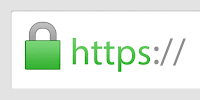SSL short for "Secure Socket Layer" is a highly sophisticated piece of technology that is most commonly known for securing exchange of information between browsers and websites. The "s" at the end of the http
s:// prefix that all secure websites addresses start with stands for secure. That at the lock sign appearing is an indication that SSL is at work protecting your content.
 |
| The only place SSL is actually ever visible |
Of course, it secures much more than just web browser sessions. It should suffice to say that this technology is a crucial part of the protective mechanism that sits under any software systems that need to speak to each other - irrespective of whether they are on the internet or not.
For those of us who are keenly interested in internet and technology, I came across a very well-written article that can serve as an excellent starting point to help one get introduced to how the concept works in a broad sense.
Read:
SSL/ TLS Strong Encryption - An Introduction
